 |
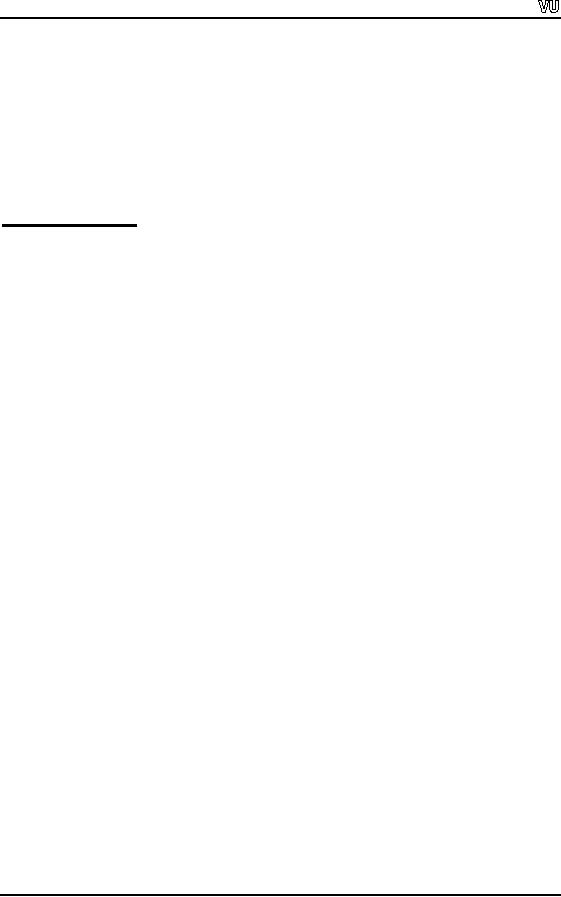
CS201
Introduction to Programming
Lecture
Handout
Introduction
to Programming
Lecture
No. 20
Reading
Material
Deitel
& Deitel - C++ How to
Program
Chapter
6, 16
6.2,
6.3, 6.4, 16.2,
16.3,
16.4, 16.5
Summary
1)
Structures
-
Declaration of a
Structure
-
Initializing
Structures
-
Functions
and structures
-
Arrays of
structures
-
sizeof
operator
2)
Sample
Program 1
3)
Sample
Program 2
4)
Unions
Structures
Today, we
will discuss the concepts of
structures and unions which
are very interesting
part of C
language. These are also in
C++. After dilating upon
structures, we will move
to
the
concept of classes, quite similar to
`structures'.
What
a structure is? We can
understand `structure' with the
example of students of
a class
discussed in some of the earlier
lectures. Suppose we have
data about students of
a
class
i.e. name, addresses, date of
birth, GPA and courses of
study. This information
is
related
to only a single entity i.e. student. To
understand the matter further, we can
think
of a car
with its specifications like model,
manufacturer company, number of seats
and so
on.
But there is always a
requirement in most of our data
processing applications that
the
relevant
data should be grouped and
handled as a group. This is
what the concept of
structure
is. In structure, we introduce a new data
type. In the previous
lectures, we had
been
dealing with int, float,
double and char in our
programs. You are fully
familiar with
Page
239
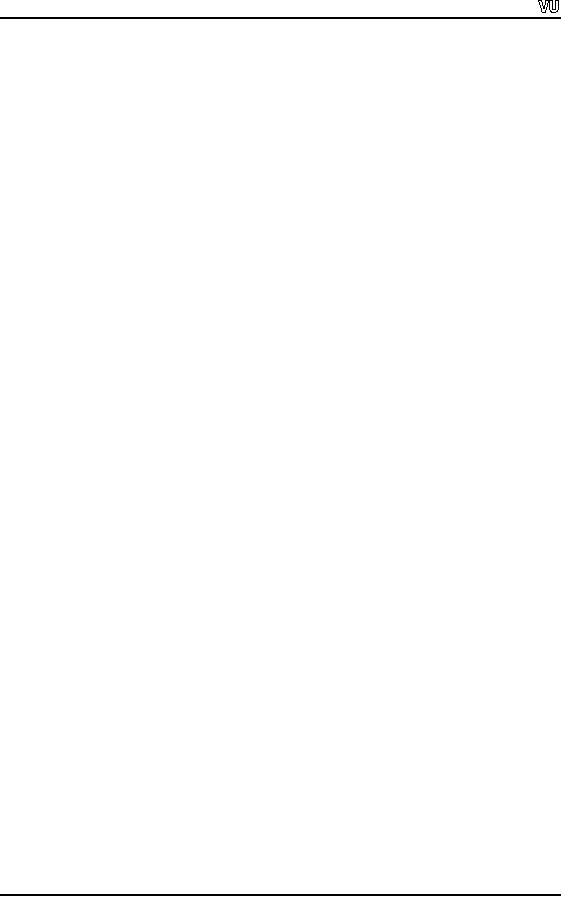
CS201
Introduction to Programming
the term
'strings' but there is no
data type called strings. We have
used `array of char'
as
strings.
While dealing with numbers,
there is no built-in mechanism to handle
the
complex
numbers. This means that
there is no data type like
complex. The FORTRAN
language
(Formula Translation) written for
scientific application, has a complex
data
type.
Therefore, in FORTRAN, we can
say complex x;
now
x
is a
variable of type
complex
and has a real part
and an imaginary part. There
is no complex data type in C
and
C++. While trying to solve
the quadratic equation on
the similar grounds, we
may
have a
complex number as answer i.e. if we
have to calculate the square
root of -1, an
iota (ί) will be
used. So the combination of
real and imaginary parts is
called complex
number.
In C, C++ we deal with such
situations with structures. So a
structure is not
simply a
grouping of real world data
like students, car etc, it
also has mathematical
usage
like
complex number. The
definition of structure is as
under:
"A
structure is a collection of variables
under a single name. These
variables can be of
different
types, and each has a
name that is used to select
it from the structure"
Declaration
of a Structure:
Structures
are syntactically defined
with the word struct. So
struct
is
another keyword
that
cannot be used as variable name.
Followed by the name of the
structure. The data,
contained
in the structure, is defined in the
curly braces. All the
variables that we
have
been
using can be part of
structure. For example:
struct
student{
char
name[60];
char
address[100];
float
GPA;
};
Here we
have a declared a structure, `student'
containing different elements. The
name of
the
student is declared as char
array. For the address, we
have declared an array
of
hundred
characters. To store the
GPA, we defined it as float variable
type. The variables
which
are part of structure are
called data members i.e. name,
address and GPA are
data
members
of student. Now
this is a new data type
which can be written
as:
student
std1, std2;
Here std1
and
std2
are
variables of type student
like
int
x, y; x and y
in this case are
variables
of int
data
type. This shows the
power of C and C++ language
and their
extensibility.
Moreover, it means that we can
create new data types
depending upon the
requirements.
Structures may also be defined at
the time of declaration in
the following
manner:
struct
student{
char
name[60];
char
address[100];
Page
240
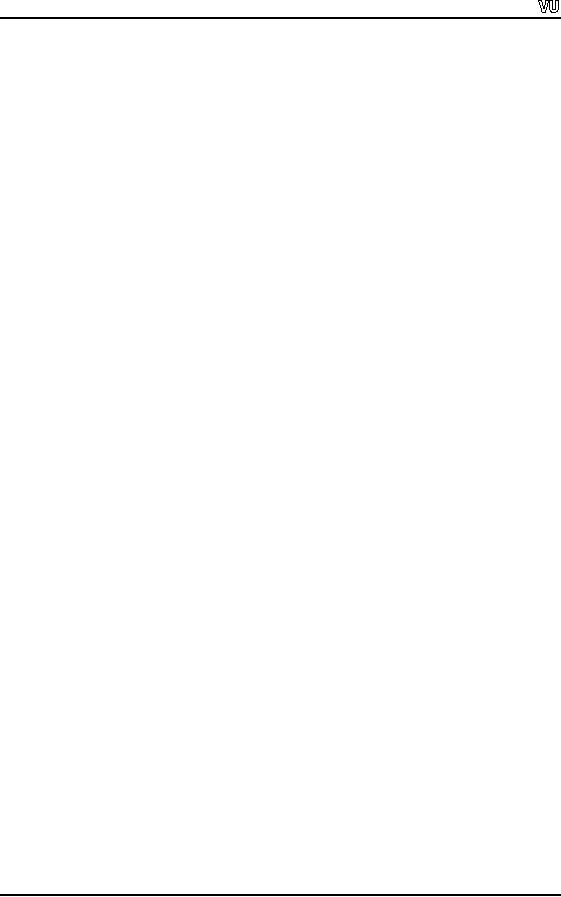
CS201
Introduction to Programming
float
GPA;
}std1,
std2;
We can
give the variable names
after the closing curly
brace of structure
declaration.
These
variables are in a comma-separated
list.
Structures
can also contain pointers
which also fall under
the category of data type.
So we
can
have a pointer to something as a part of a
structure. We can't have the
same structure
within
itself but can have
other structures. Let's say
we have a structure of an address.
It
contains
streetAddress like 34 muslim
town, city like sukhar,
rawalpindi, etc and
country
like
Pakistan. It can be written in C
language as:
struct
address{
char
streetAddress[100];
char
city[50];
char
country[50];
}
Now
the structure address
can be a
part of student
structure.
We can rewrite student
structure
as under:
struct
student{
char
name[60];
address
stdAdd;
float
GPA;
};
Here stdAdd
is a
variable of type Address
and a
part of student
structure.
So we can have
pointers
and other structures in a
structure. We can also have
pointers to a structure in a
structure.
We know that pointer hold
the memory address of the
variable. If we have a
pointer to an
array, it will contain the
memory address of the first
element of the array.
Similarly,
the pointer to the structure points to
the starting point where the
data of the
structure
is stored.
We have
used the card-shuffling example
before. What will be the
structure of card?
Its
one
attribute may be the suit i.e.
spades, clubs, diamonds or hearts.
The second attribute
is the
value of the card like
ace, deuce, 3 up to king.
The structure of card
contains a char
pointer to
suit and a char pointer to
value i.e.
struct
card {
char
*suit;
char
*value;
};
card
card1, card2;
Page
241
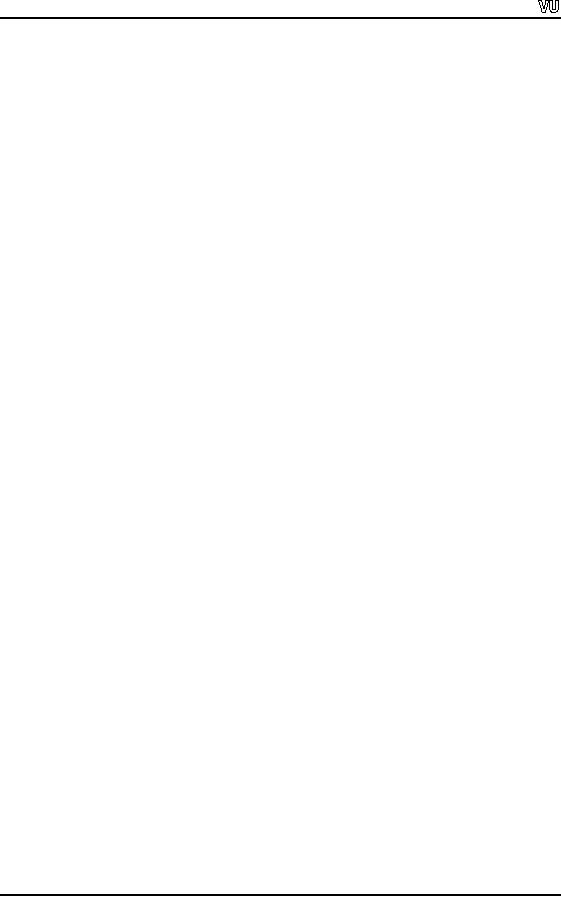
CS201
Introduction to Programming
We have
defined card1
and
card2
of
type card. We can
also define more cards. There
are
also
arrays of structure. The syntax is
same as with the normal
data type. So a set of
cards
or an
array of hundred students
can be defined as
under:
card
fullSet[52];
student
s[100];
The
pointers to structure can be defined in
the following manner
i.e.
student
*sptr;
Here sptr
is a
pointer to a data type of structure student. Briefly
speaking, we have
defined a
new data type. Using
structures we can
declare:
� Simple
variables of new
structure
� Pointers
to structure
� Arrays
of structure
There
are also limitation with
structures as we can not say
card1 +
card2; As
the
operator
plus (+) does not know how
to add two structures. We
will learn to
overcome
these
limitations at the advanced
stage. On the other hand,
assignment of structures
works.
Therefore if s1
and
s2
are of
type student
structure,
we can say that s1 =
s2.
The
assignment
works because the structure
is identical. So the name
will be
copied to the
name, address
to
address
and so
on. If we want to display the
structure with cout, it
will
also
work. The cout
is a
very intelligent function as it
interprets the structure
besides
showing
the output.
Initializing
Structures
We have
so far learnt how to define a structure
and declare its variables.
Let's see how
can we
put the values in its
data members. The following
example can help us
understand
the
phenomenon further.
struct
student{
char
name[64];
char
course[128];
int
age;
int
year;
};
student
s1, s2, s3;
Once
the structure is defined,
the variables of that
structure type can be
declared.
Initialization
may take place at the
time of declaration i.e.
student
s1 = {"Ali", "CS201", 19,
2002 };
Page
242
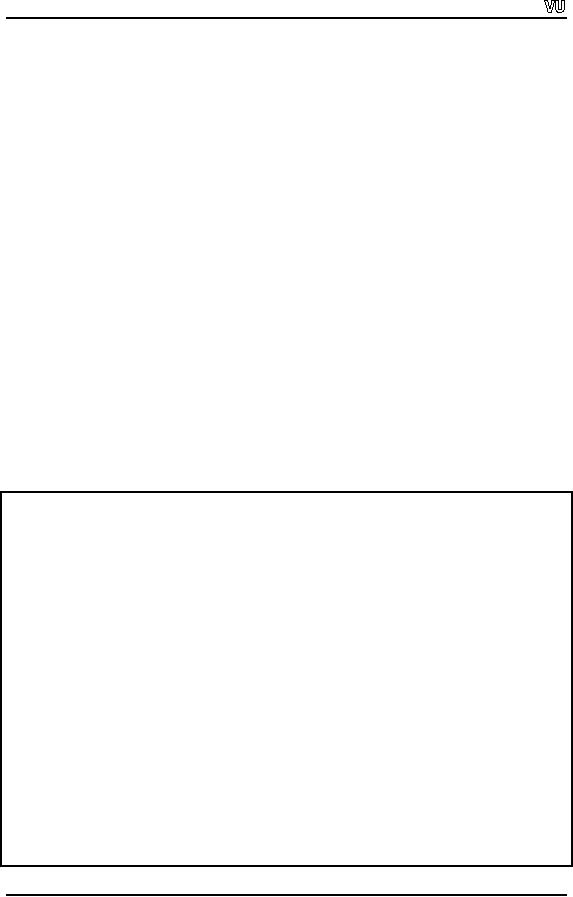
CS201
Introduction to Programming
In the
above statement, we have
declared a variable s1
of
data type student
structure
and
initialize
its data member. The values
of data members of s1
are
comma separated in
curly
braces. "Ali" will be assigned to
name, "CS201"
will be assigned to the course,
19
to age
and
2002 to year. So far we
have not touched these
data members
directly.
To access
the data members of
structure, dot operator (.)
is used. Therefore
while
manipulating
name
of
s1, we will
say s1.name.
This is a
way of referring to a data
member of a
structure. This may be
written as:
s1.age =
20;
s1.year =
2002;
The
above statement will assign
the value 20 to the age
data
member of structure s1.
Can
we assign
a string to the name of s1? Write
programs to see how to do
this? You may
need
string copy function to do this. Also,
initialize the pointers to
structure and see
what
is the
difference.
Similarly,
to get the output of data
members on the screen, we
use dot operator. To
display
the name
of
s1
we
can write it as:
cout
<< "The name of s1 = " <<
s1.name;
Other
data members can be
displayed on the screen in
the same fashion.
Here is a
simple example showing the
initialization and displaying
the structure.
/* Simple
program showing the
initialization of structure.*/
#include
<iostream.h>
main()
{
//
Declaring student
structure
struct
student{
char
name[64];
char
course[128];
int
age;
int
year;
};
//
Initializing the
structure
student
s1 = {"Ali", "CS201- Introduction to
programming", 22,
2002};
cout
<< "Displaying the structure
data members" << endl;
cout
<< "The name is " << s1.name
<< endl;
cout
<< "The course is " <<
s1.course << endl;
cout
<< "The age is " << s1.age
<< endl;
cout
<< "The year is " << s1.year
<< endl;
}
Page
243
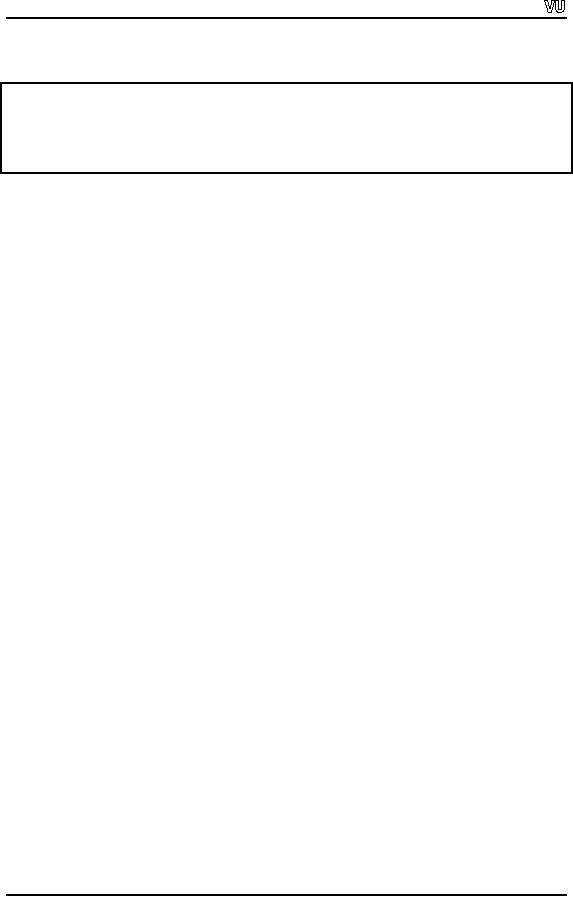
CS201
Introduction to Programming
The
output of the above program
is:
Displaying
the structure data
members
The
name is Ali
The
course is CS201- Introduction to
programming
The
age is 22
The
year is 2002
Here, s1
is a
unit. The data members
have been grouped together.
If we have s1
and
s2
as
two
variables of student type and
want to copy the data of s1
to
s2, it can
be written as:
s2 =
s1;
Functions
and structures
We can
pass structures to functions. Structures
are passed into functions as
per the C/C++
calling
conventions by value. In other
words, a copy of entire structure is
put on the
stack.
The function is called which
removes it from the stack
and uses the structure.
We
can
also pass the structures by
reference to function. This
can be performed in the
same
way we do
with the normal variables
i.e. pass the address of the
structure to the
function.
This is
call by reference.
When we
pass an array to a function,
the reference of the array
is passed to the
function.
Any
change in the array elements
changes the original array.
Suppose we have a
structure
containing an
array. What will happen to
the array if the structures
are passed as value?
Is
the
array passed as value or
reference? As the array is a
part of structure, it will be
passed
as value.
The advantage of `pass by
value' process is that if
the function makes
some
changes
to the array elements, it
does not affect the original
array. However, it may
be
disadvantageous
as the complete array is copied on
the stack and we can
run out of
memory
space. So be careful while passing
the structures to functions. We know
that
functions
return value, int, char
etc. Similarly functions can
also return structures. In
a
way,
the behavior of structure is
same as ordinary data
type.
Suppose
we have a pointer to structure as student
*sptr; here
sptr
is a
pointer to student.
Now
s1
is a
variable of type student
and
sptr = &s1
and sptr is
pointing to s1. How
can
we access
the data with sptr? We
cannot say *sptr.name. The
precedence of dot
operator
(.) is
higher than * operator. So
dot operator is evaluated
first and then * operator.
The
compiler
will give error on the
above statement. To get the
results, we have to evaluate
*
operator
first i.e. (*sptr).name
will
give the desired result.
There is another easy and
short
way to
access the structure's data member i.e.
using the arrow (->) in
place of dot
operator.
We normally use the arrow
(-> i.e. minus sign and
then the greater than sign)
to
manipulate
the structure's data with
pointers. So to access the
name with sptr
we
will
write:
sptr->name;
Page
244
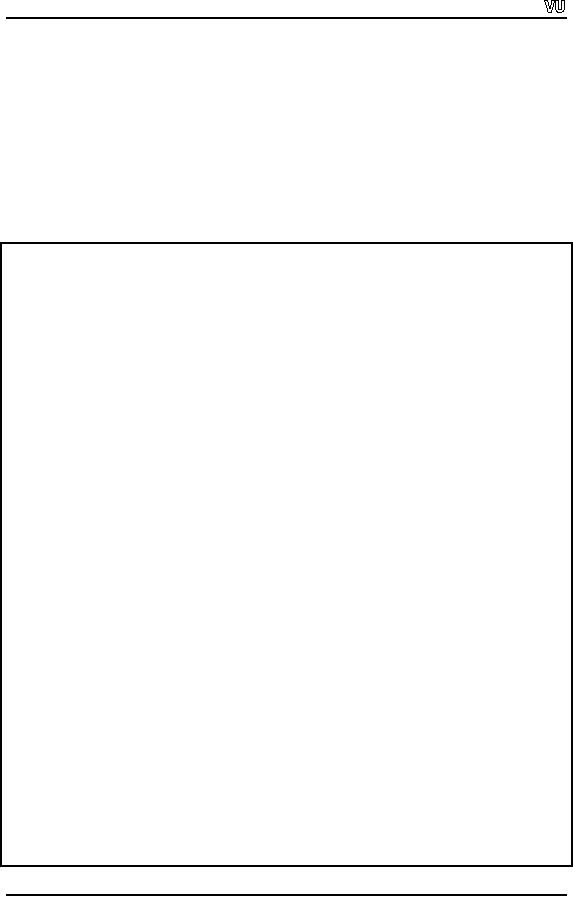
CS201
Introduction to Programming
Remember
the difference between the
access mechanism of structure while
using the
simple
variable and pointer.
While
accessing through a simple variable,
use dot operator i.e.
s1.name
While
accessing through the pointer to
structure, use arrow
operator i.e. sptr-
>name;
Following
is the example, depicting the access
mechanism of structure's data member
using
the pointer to structure.
The
code of the sample example
is:
/* This
program shows the access of
structure data members with
pointer to structure */
#include
<iostream.h>
main()
{
// Declaration of
student structure
struct
student{
char
name[64];
char
course[128];
int
age;
int
year;
};
//
Initializing the s1
student
s1 = {"Ali", "CS201- Introduction to
programming", 22,
2002};
student
*sptr;
//
Assigning a structure to pointer
sptr =
&s1;
cout
<< "Displaying the structure
data members using pointers" <<
endl;
cout
<< "Using the * operator" <<
endl;
cout
<< endl;
cout
<< "The name is " << (*sptr).name <<
endl;
cout
<< "The course is " << (*sptr).course
<< endl;
cout
<< "The age is " << (*sptr).age <<
endl;
cout
<< "The year is " << (*sptr).year <<
endl;
cout
<< endl;
cout
<< "Using the -> operator"
<< endl;
cout
<< endl;
cout
<< "The name is " <<
sptr->name << endl;
cout
<< "The course is " <<
sptr->course << endl;
cout
<< "The age is " <<
sptr->age << endl;
cout
<< "The year is " <<
sptr->year << endl;
}
Page
245
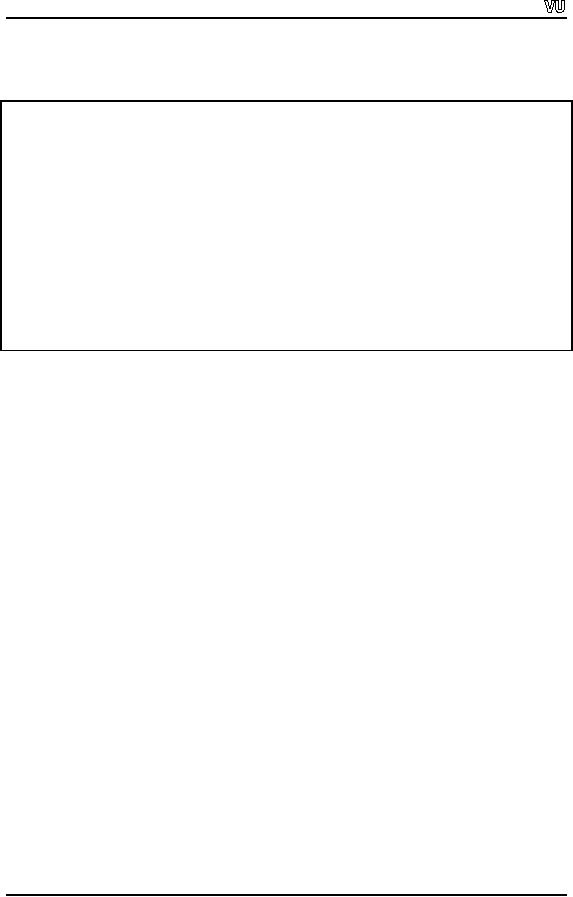
CS201
Introduction to Programming
The
output of the program is:
Displaying
the structure data members
using pointers
Using
the * operator
The
name is Ali
The
course is CS201- Introduction to
programming
The
age is 22
The
year is 2002
Using
the -> operator
The
name is Ali
The
course is CS201- Introduction to
programming
The
age is 22
The
year is 2002
Arrays
of structures
Let's
discuss the arrays of
structure. The declaration is
similar as used to deal with
the
simple
variables. The declaration of
array of hundred students is as
follows:
student
s[100];
In the
above statement, s
is an
array of type student
structure.
The size of the array
is
hundred
and the index will be
from 0 to 99. If we have to
access the name
of
first student,
the
first element of the array
will be as under:
s[0].name;
Here s
is
the array so the index
belongs to s.
Therefore the first student
is s[0], the 2nd
student
is s[1] and so on. To access
the data members of the
structure, the dot operator
is
used.
Remember that the array
index is used with the
array name and not
with the data
member of
the structure.
Sizeof
operator
As
discussed earlier, the
sizeof operator is used to
determine the size of data
type. The
sizeof
operator can also be used
with the structure.
Structure contains different
data types.
How
can we determine its size in
the memory? Consider the
student structure
that
contains
two char arrays and
two int data types. We
can simply use the
sizeof operator to
determine
its size. It will tell us
how many bytes the structure
is occupying.
sizeof(s1);
We don't
need to add the size of all
the data members of the
structure. This operator
is
very
useful while using the write()
function
to write the structure in
the file.
Page
246
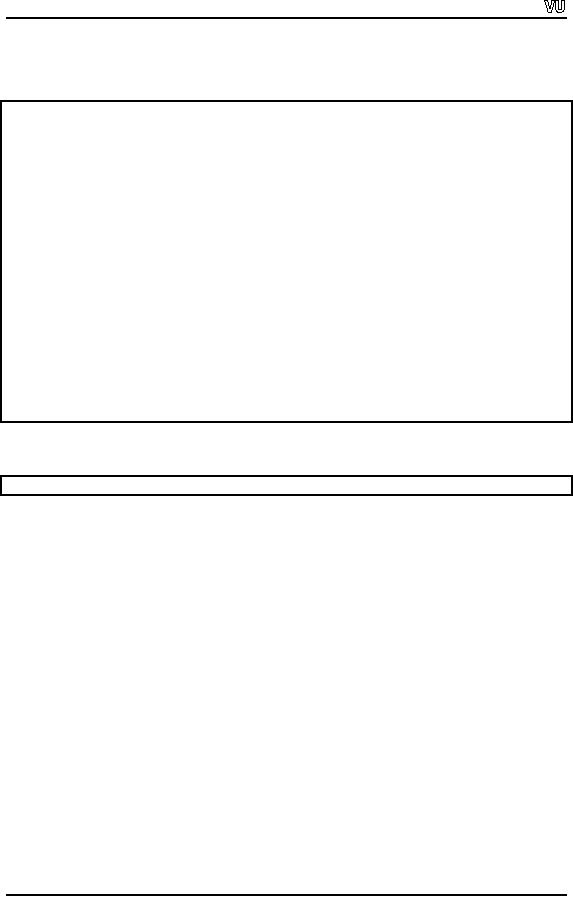
CS201
Introduction to Programming
Here is a
small example which shows
the number of bytes a
structure occupies in
memory.
/* this
program shows the memory
size of a structure*/
#include
<iostream.h>
main()
{
//
Declaring student
structure
struct
student{
char
name[64];
char
course[128];
int
age;
int
year;
};
student
s1 = {"Ali", "CS201- Introduction to
programming", 22,
2002};
// using
sizeof operator to determine
the size
cout
<< "The structure s1 occupies "
<< sizeof(s1) << " bytes in the
memory";
}
The
output of the above program
is:
The
structure s1 occupies 200
bytes in the memory
Let's
summarize what we can do
with structures:
�
We can
define the structure
�
We can
declare variables of that type of
structure
�
We can
declare pointers to
structure
�
We can
declare arrays of
structure
�
We can
take the size of
structure
�
We can do
simple assignment of two
variables of the same
structure type
Sample
Program 1
Problem:
Suppose
we have ten students in a
class. The attributes of
student are name, course,
age
and
GPA. Get the data
input from the user to
populate the array. Calculate
the average
age,
average GPA of the class.
Find out the grade of
the class and student
with max GPA.
Solution:
The
problem is very simple. We
will declare a structure of
student with name, course,
age
and
GPA as data members. In a
loop, we will get the
data from the user to
populate the
Page
247
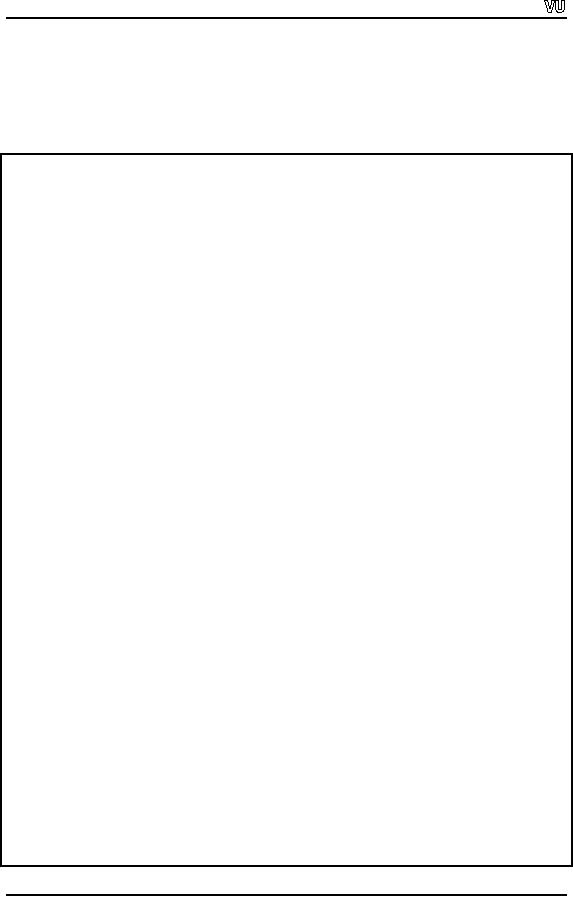
CS201
Introduction to Programming
array.
Then in a loop, we will calculate
the totalAge
and
totalGPA
of
the class besides
determining
the max GPA in that loop.
Finally calculate the
average age and
average
GPA by
dividing the totalAge
and
totalGPA
by
the number of students i.e.
10. The grade
of the
class can be determined by
the average GPA.
The
complete code of the program
is:
/* This
program calculates the
average age and average
GPA of a class. Also
determine
the
grade of the class and
the student with max
GPA. We will use a student
structure and
manipulate it to
get the desired result.
*/
#include
<iostream.h>
main()
{
// Declaration of
student structure
struct
student
{
char
name[30];
char
course[15];
int
age;
float
GPA;
};
const
int noOfStudents =
10;
// total
no of students
student
students[noOfStudents];
// array
of student structure
int
totalAge, index,
averageAge;
float
totalGPA, maxGPA,
averageGPA;
//
initializing the structure, getting
the input from
user
for (
int i = 0; i < noOfStudents; i++
)
{
cout
<< endl;
cout
<< "Enter data for
Student # : " << i + 1 << endl;
cout
<< "Enter the Student's
Name : " ;
cin
>> students[i].name ;
cout
<< "Enter the Student's
Course : " ;
cin
>> students[i].course ;
cout
<< "Enter the Student's
Age : " ;
cin
>> students[i].age ;
cout
<< "Enter the Student's
GPA : " ;
cin
>> students[i].GPA ;
}
maxGPA =
0;
//
Calculating the total age,
total GPA and max
GPA
for (
int j = 0; j < noOfStudents; j++
)
Page
248
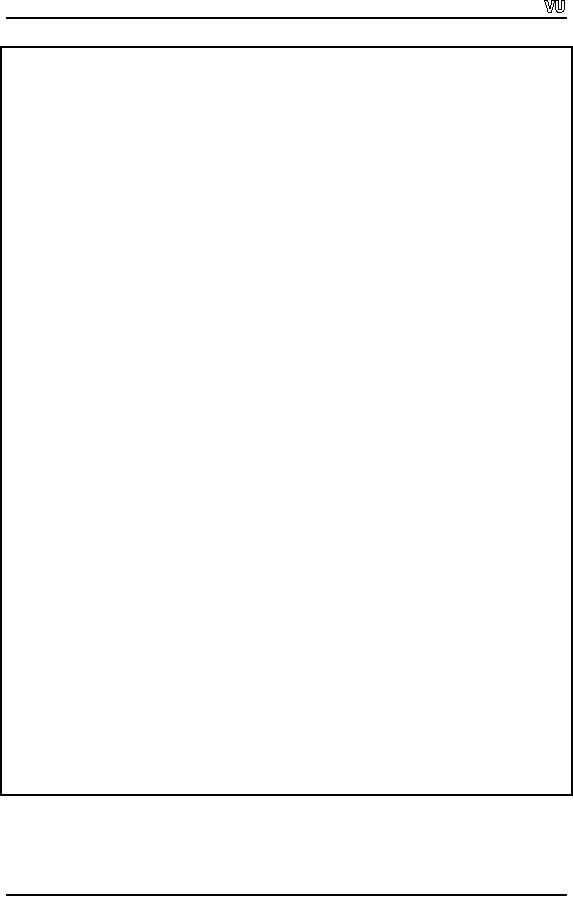
CS201
Introduction to Programming
{
totalAge
= totalAge + students[j].age ;
totalGPA
= totalGPA + students[j].GPA ;
//
Determining the max GPA
and storing its index
if (
students[j].GPA > maxGPA )
{
maxGPA =
students[j].GPA;
index =
j;
}
}
//
Calculating the average
age
averageAge
= totalAge / noOfStudents ;
cout
<< "\n The average age
is : " << averageAge << endl;
//
Calculating the average
GPA
averageGPA
= totalGPA / noOfStudents ;
cout
<< "\n The average GPA
is : " << averageGPA << endl;
cout
<< "\n Student with
max GPA is : " << students[index].name <<
endl ;
//
Determining the Grade of the
class
if
(averageGPA > 4)
{
cout
<< "\n Wrong grades
have been enter" <<
endl ;
}
else if (
averageGPA == 4)
{
cout
<< "\n The average
Grade of the class is : A" <<
endl;
}
else if (
averageGPA >= 3)
{
cout
<< "\n The average
Grade of the class is : B" <<
endl;
}
else if (
averageGPA >= 2)
{
cout
<< "\n The average
Grade of the class is : C" <<
endl;
}
else
{
cout
<< "\n The average
Grade of the class is : F" <<
endl;
}
}
The
output of the program with three
students i.e. when noOfStudents =
3
Page
249
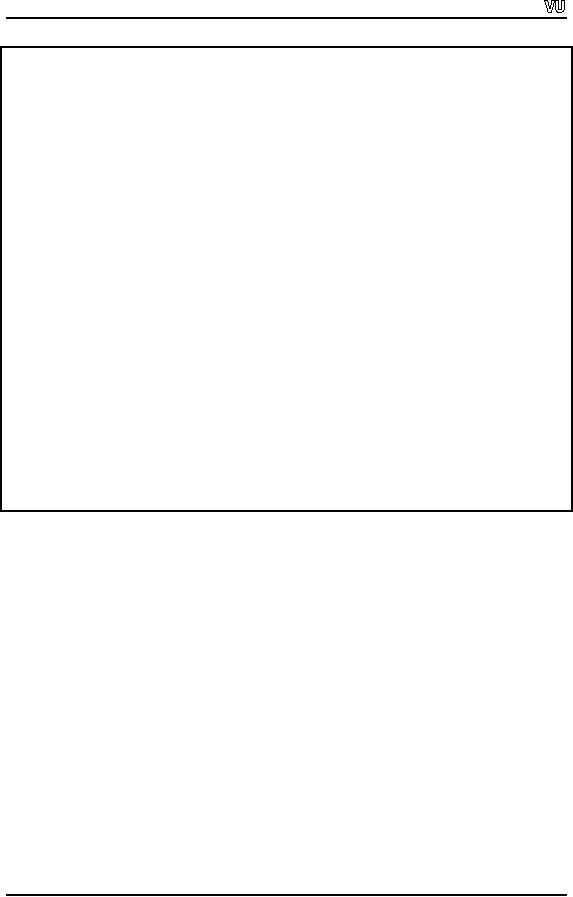
CS201
Introduction to Programming
Enter
data for Student # :
1
Enter
the Student's Name :
Ali
Enter
the Student's Course :
CS201
Enter
the Student's Age :
24
Enter
the Student's GPA :
3.5
Enter
data for Student # :
2
Enter
the Student's Name :
Faisal
Enter
the Student's Course :
CS201
Enter
the Student's Age :
22
Enter
the Student's GPA :
3.6
Enter
data for Student # :
3
Enter
the Student's Name :
Jamil
Enter
the Student's Course :
CS201
Enter
the Student's Age :
25
Enter
the Student's GPA :
3.3
The
average age is : 24
The
average GPA is :
3.46667
Student
with max GPA is :
Faisal
The
average Grade of the class
is : B
Sample
Program 2
Problem:
Read
the student data from a
file, populate the structure
and write the structure in
another
file.
Solution:
We have
to read from a file. We will
write a function which will
read from a file
and
return a
structure to the calling
program. The prototype of function
is:
returnType
functionName (argument
list)
As the
function is returning a student structure
so the return type will be
`student'.
We
can
name the function as
getData() as it is reading from a
file a returning the data
(i.e.
student
structure). In the arguments, we
can give it the handle of
the file from which
the
data is
to be read. For the
simplicity, we keep the
argument list empty. Therefore,
the
prototype of
our function is as
under:
student
getData();
Page
250
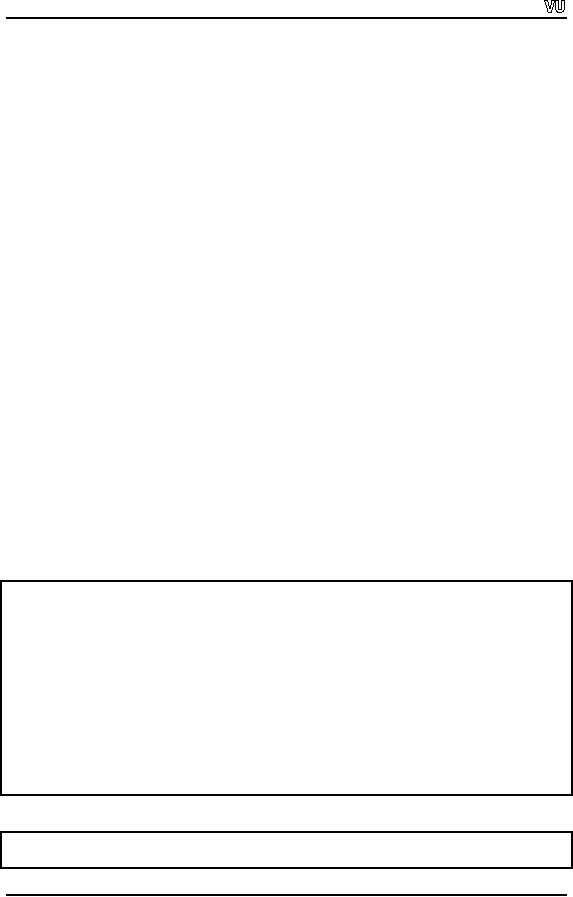
CS201
Introduction to Programming
This
function is going to read from a
file. The handle of the
file has to be global so
that
function
can access that file
handle. We will define the
handle of the file before
main
function
to make it global. We will open
the file in the main
function
before calling the
getData
function.
The getData
function
returns a student structure
.We will assign this
to
some
variable of type student like:
s1 =
getData();
Where
s1
is a
variable of type student. It
means that the structure,
returned by the getData
function
is assigned to s1. The
getData
function
can read the data
from the file
using
extraction
operators (i.e. >>). As this
function is returning a student
structure, we declare
tmpStd
of
type student. Data
read from the file
will be assigned to the tmpStd. In the
end
of the
getData
function,
we will return the tmpStd
using
the return keyword (i.e.
return
tmpStd).
Let's
have a look what is
happening in the memory. When we
entered into the getData
function
from main, it creates
locally a tmpStd
of
type student structure. tmpStd
is
created
somewhere
in the memory. It starts
reading data from the
file assigning it at that
memory
location. On
its return, the function
copies this tmpStd
on to
the stack. Stack is the
way
the
function communicates with the
main function or calling program. When
the function
returns,
it will destroy the tmpStd
as it
is local variable of getData
function.
It does not
exist
anymore. It just came into
being while you were inside
the getData
function.
It
disappears
once getData
finishes.
However, before it disappears,
the getData
copies
tmpStd
in
the memory so the main
function pick up those value
use it to assign to s1.
Similarly
we write the writeData
function
to write the data into a
file. We will pass
this
function
a student type structure to write it on
the file. The prototype of
writeData
is
as:
void
writeData(student s1);
The
sample input file:
nasir
CS201
23
3
Jamil
CS201
31
4
Faisal
CS201
25
3.5
Here is
the complete code of the
program:
/* this
program reads from a file,
populate the structure, and
write the structure in a
file */
Page
251
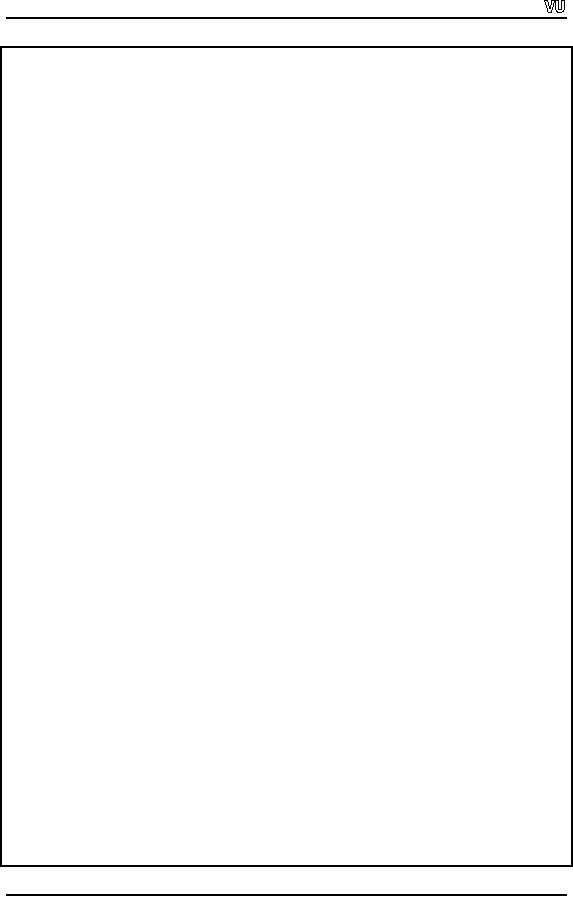
CS201
Introduction to Programming
#include
<stdlib.h>
#include
<fstream.h>
// Global
variables for input and
output files
ifstream
inFile;
ofstream
outFile;
//student
structure
struct
student
{
char
name[30];
char
course[15];
int
age;
float
GPA;
};
//
function declarations
void
openFile();
// open
the input and output
files
student
getData();
// Read
the data from the
file
void
writeData(student);
// write
the structure into a
file
void
main()
{
const
int noOfStudents = 3;
// Total
no of students
openFile();
//
opening input and output
files
student
students[noOfStudents]; // array of
students
//
Reading the data from
the file and populating the
array
for(int i
= 0; i < noOfStudents; i++)
{
if
(!inFile.eof())
{
students[i] =
getData();
}
else
{
break
;
}
}
//
Writing the structures to
the file
for(int i
= 0; i < noOfStudents; i++)
{
writeData(students[i]);
}
Page
252
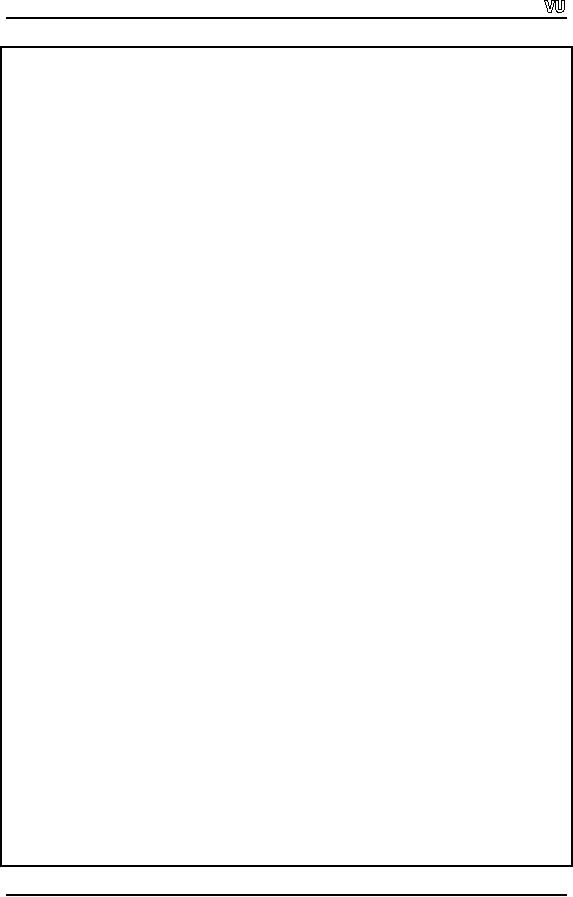
CS201
Introduction to Programming
//
Closing the input and output
files
inFile.close ( )
;
outFile.close ( )
;
}
/* This
function opens the input
file and output file
*/
void
openFile()
{
inFile.open("SAMPLE.TXT",
ios::in);
inFile.seekg(0L,
ios::beg);
outFile.open("SAMPLEOUT.TXT",
ios::out | ios::app);
outFile.seekp(0L,
ios::end);
if(!inFile
|| !outFile)
{
cout
<< "Error in opening the
file" << endl;
exit(1);
}
}
/* This
function reads from the
file */
student
getData()
{
student
tempStudent;
// temp
variables for reading the
data from file
char
tempAge[2];
char
tempGPA[5];
//
Reading a line from the
file and assigning to the
variables
inFile.getline(tempStudent.name,
'\n');
inFile.getline(tempStudent.course,
'\n');
inFile.getline(tempAge,
'\n');
tempStudent.age
= atoi(tempAge);
inFile.getline(tempGPA,
'\n');
tempStudent.GPA =
atof(tempGPA);
// Returning
the tempStudent
structure
return
tempStudent;
}
/* This
function writes into the
file the student
structure*/
void
writeData(student writeStudent)
{
outFile
<< writeStudent.name << endl;
outFile
<< writeStudent.course << endl;
outFile
<< writeStudent.age << endl;
Page
253
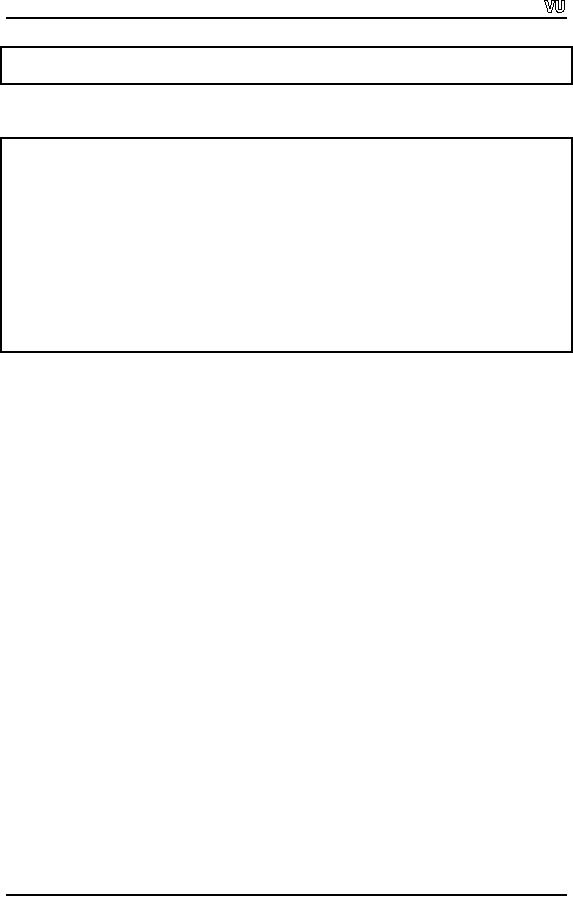
CS201
Introduction to Programming
outFile
<< writeStudent.GPA << endl;
}
The
contents of output file
is:
nasir
CS201
23
3
Jamil
CS201
31
4
Faisal
CS201
25
3.5
Unions
We have
another construct named union.
The concept of union in C/C++
is: if we have
something in
the memory, is there only
one way to access that
memory location or
there
are
other ways to access it. We
have been using int and
char interchangeably in
our
programs.
We have already developed a program
that prints the ACSII codes.
In this
program,
we have stored a char inside an
integer. Is it possible to have a
memory location
and
use it as int or char
interchangeably? For such
purposes, the construct union is
used.
The
syntax of union is:
union
intOrChar{
int
i,
char
c;
};
The
syntax is similar as that of structure.
In structures, we have different
data members
and
all of these have their
own memory space. In union,
the memory location is
same
while
the first data member is one
name for that memory
location. However, the 2nd data
member is
another name for the
same location and so on.
Consider the above union
(i.e.
intOrChar)
that contains an integer and
a character as data members.
What will be the
size of
this union? The answer is
the very simple. The union
will be allocated the
memory
equal to that of the largest
size data member. If the int
occupies four bytes
on
our
system and char occupies
one byte, the union intOrChar
will
occupy four bytes.
Consider
another example:
union
intOrDouble{
int
ival;
Page
254
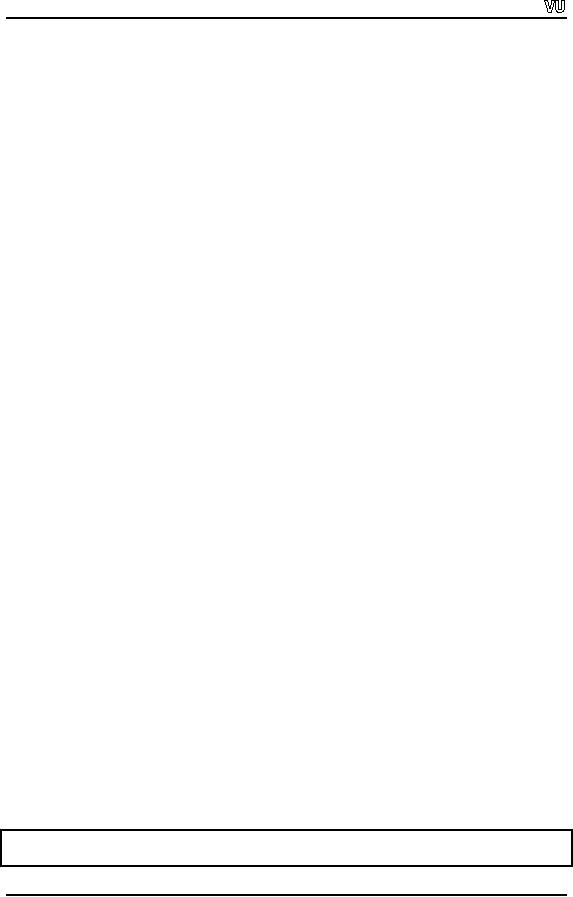
CS201
Introduction to Programming
double
dval;
};
The
above union has two data
members i.e. ival
of
type int and dval
of
type double. We
know
that double occupies more
memory space than integer.
Therefore, the union
will
occupy
the memory space equivalent to
double. The data members of
unions are accessed
in a
similar way as we use with
structures i.e. using the
dot operator. For
example:
intOrDouble
uval;
uval.ival
= 10;
To get
the output of the data
members, cout can be used
as:
cout
<< " The value in ival = " <<
uval.ival;
It will
print "The value in ival =
10". Now what will be output
of the following
statement?
cout
<< " The value in dval = " <<
uval.dval;
We don't
know. The reason is that in
the eight bytes of double,
integer is written
somewhere.
When we use integer, it is printed fine.
When we printed the double,
the
value of
int will not be displayed.
Rather something else will be printed.
Similarly in the
following
statement i.e.
uval.dval
= 100.0;
cout
<< " The value in dval = " <<
uval.dval;
It will
print the right value of
dval. The
value of this double is
written in such a way
that
it will
not be interpreted by the integer. If we
try to print out ival, it will
not display 100.
Unions
are little bit safer
for integer and characters.
But we have to think in
terms that
where to
store the value in
memory.
Suppose,
we have some integer value
123 and want to append
456 to it so that it
becomes
123456.
How can we do that? To obtain
this result, we have to
shift the integer
three
decimal
places i.e. we can multiply
the integer 123 by 1000
(i.e. 123000) and then
add
456 to it
(i.e. 123456). Consider a union containing
four characters and an
integer. Now
the size
of the char is one and
integer is four so the size of
the union will be four.
We
assign
the character `a' to the
integer, and display the
chars and integer value. If
we want
to shift
the value of first byte
into the second byte,
the integer will be
multiplied by
256(i.e.
A byte contains 8 bits and 2 to
power 8 is 256), then add
character `b' to it.
We
see
that the char variables of
union contains `a' and
`b'.
Here is
the code of the
program;
/* This
program uses a union of int
and char and display the
memory usage by both
*/
#include
<iostream.h>
Page
255
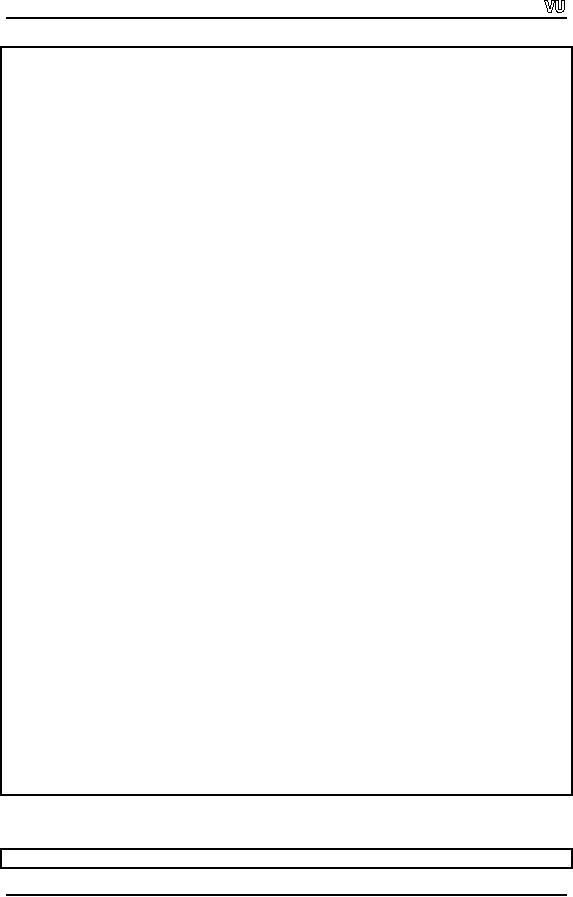
CS201
Introduction to Programming
main()
{
// Declaration of
union
union
intOrChar{
char
c[4];
int
x;
}u1;
u1.x =
'a';
//
Assigning `a' to x
//
Displaying the char array
and integer value
cout
<< "The value of c = " << u1.c[0] <<
"," << u1.c[1]
<<
"," << u1.c[2] << ","
<< u1.c[3]<< endl;
cout
<< "The value of x = " << u1.x <<
endl;
//
Shifting the values one
byte and adding `b' to
the int
u1.x *=
256;
u1.x +=
'b';
//
Displaying the char array
and integer value
cout
<< "The value of c = " << u1.c[0] <<
"," << u1.c[1]
<<
"," << u1.c[2] << ","
<< u1.c[3]<< endl;
cout
<< "The value of x = " << u1.x <<
endl;
//
Shifting the values one
byte and adding `b' to
the int
u1.x *=
256;
u1.x +=
'c';
//
Displaying the char array
and integer value
cout
<< "The value of c = " << u1.c[0] <<
"," << u1.c[1]
<<
"," << u1.c[2] << ","
<< u1.c[3]<< endl;
cout
<< "The value of x = " << u1.x <<
endl;
//
Shifting the values one
byte and adding `b' to
the int
u1.x *=
256;
u1.x +=
'd';
//
Displaying the char array
and integer value
cout
<< "The value of c = " << u1.c[0] <<
"," << u1.c[1]
<<
"," << u1.c[2] << ","
<< u1.c[3]<< endl;
cout
<< "The value of x = " << u1.x <<
endl;
}
The
output of the program is;
The
value of c = a, , ,
Page
256
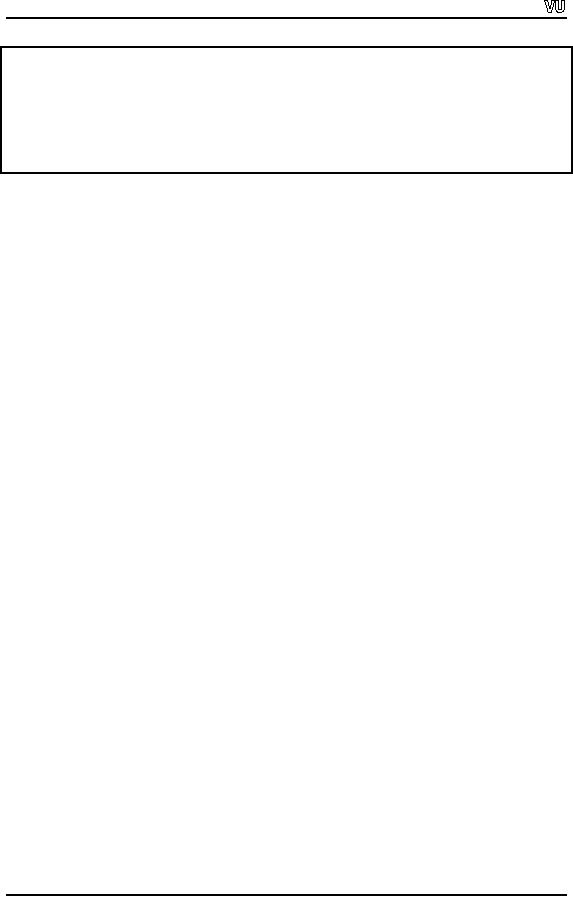
CS201
Introduction to Programming
The
value of x = 97
The
value of c = b,a, ,
The
value of x = 24930
The
value of c = c,b,a,
The
value of x = 6382179
The
value of c = d,c,b,a
The
value of x = 1633837924
Unions
are very rarely used. They
become very important when
we want to do some
super
efficient programming. Experiment with
the unions and
structures.
We have
learnt how to use structures
and unions. These are
relatively less used parts
of
C/C++
language. But structures at
least are very useful. They
allow us a convenient
way
of grouping
data about a single entity. We
have used student entity in
our example. You
can
think of a car or any other
object and find out its
properties before grouping them in
a
structure.
We don't need to manipulate its
properties individually as grouping them
into a
unit is a
better option. Try to write
different programs using
structures.
Page
257
Table of Contents:
- What is programming
- System Software, Application Software, C language
- C language: Variables, Data Types, Arithmetic Operators, Precedence of Operators
- C++: Examples of Expressions, Use of Operators
- Flow Charting, if/else structure, Logical Operators
- Repetition Structure (Loop), Overflow Condition, Infinite Loop, Properties of While loop, Flow Chart
- Do-While Statement, for Statement, Increment/decrement Operators
- Switch Statement, Break Statement, Continue Statement, Rules for structured Programming/Flow Charting
- Functions in C: Structure of a Function, Declaration and Definition of a Function
- Header Files, Scope of Identifiers, Functions, Call by Value, Call by Reference
- Arrays: Initialization of Arrays, Copying Arrays, Linear Search
- Character Arrays: Arrays Comparisonm, Sorting Arrays Searching arrays, Functions arrays, Multidimensional Arrays
- Array Manipulation, Real World Problem and Design Recipe
- Pointers: Declaration of Pointers, Bubble Sort Example, Pointers and Call By Reference
- Introduction, Relationship between Pointers and Arrays, Pointer Expressions and Arithmetic, Pointers Comparison, Pointer, String and Arrays
- Multi-dimensional Arrays, Pointers to Pointers, Command-line Arguments
- String Handling, String Manipulation Functions, Character Handling Functions, String Conversion Functions
- Files: Text File Handling, Output File Handling
- Sequential Access Files, Random Access Files, Setting the Position in a File, seekg() and tellg() Functions
- Structures, Declaration of a Structure, Initializing Structures, Functions and structures, Arrays of structures, sizeof operator
- Bit Manipulation Operators, AND Operator, OR Operator, Exclusive OR Operator, NOT Operator Bit Flags Masking Unsigned Integers
- Bitwise Manipulation and Assignment Operator, Programming Constructs
- Pre-processor, include directive, define directive, Other Preprocessor Directives, Macros
- Dynamic Memory Allocation, calloc, malloc, realloc Function, Dangling Pointers
- History of C/C++, Structured Programming, Default Function Arguments
- Classes and Objects, Structure of a class, Constructor
- Classes And Objects, Types of Constructors, Utility Functions, Destructors
- Memory Allocation in C++, Operator and Classes, Structures, Function in C++,
- Declaration of Friend Functions, Friend Classes
- Difference Between References and Pointers, Dangling References
- Operator Overloading, Non-member Operator Functions
- Overloading Minus Operator, Operators with Date Class, Unary Operators
- Assignment Operator, Self Assignmentm, Pointer, Conversions
- Dynamic Arrays of Objects, Overloading new and delete Operators
- Source and Destination of streams, Formatted Input and Output, Buffered Input/Output
- Stream Manipulations, Manipulators, Non Parameterized Manipulators, Formatting Manipulation
- Overloading Insertion and Extraction Operators
- User Defined Manipulator, Static keyword, Static Objects
- Pointers, References, Call by Value, Call by Reference, Dynamic Memory Allocation
- Advantages of Objects as Class Members, Structures as Class Members
- Overloading Template Functions, Template Functions and Objects
- Class Templates and Nontype Parameters, Templates and Static Members
- Matrices, Design Recipe, Problem Analysis, Design Issues and Class Interface
- Matrix Constructor, Matrix Class, Utility Functions of Matrix, Input, Transpose Function
- Operator Functions: Assignment, Addition, Plus-equal, Overloaded Plus, Minus, Multiplication, Insertion and Extraction